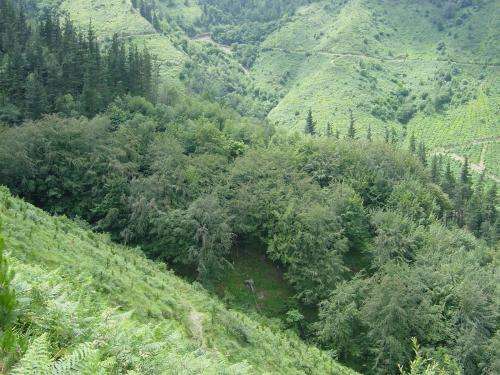Pine plantations provide optimum conditions for natural forests to develop underneath them

If there is any native forest in the vicinity, tree, fern and herbaceous species typical of these forests penetrate under the pine plantations without any need for action. That way it is possible, to a certain extent, for native forests to be restored, thanks to the process known as ecological succession. This is the conclusion reached by the UPV/EHU's Landscape, Biodiversity and Ecosystem Services group in its research carried out on the pine plantations of Bizkaia. The work has been published in the journal Forest Ecology and Management.
In many European countries forestry authorities have started to take the sustainable management of forests into consideration. As a result, greater importance has begun to be attached to the restoration and encouragement of native forests. "Forestry is currently going through a unique time as a result of the fall in the profitability of the plantations of exotic, rapid-growth species," says Ibone Ametzaga, member of the UPV/EHU's Landscape, Biodiversity and Ecosystem Services group.
Nowadays, mixed native forests, in other words, the ones in which the predominant species is the oak (Quercus robur), "occupy no more than 3% of the surface they could occupy in Bizkaia and Gipuzkoa," explained Ametzaga. However, this research group has concluded that oak groves make a much more significant contribution than plantations to the well-being of society. This was the conclusion they reached when developing the International Millennium Ecosystem Assessment Programme in Bizkaia. This programme involves assessing the services provided by ecosystems.

The benefits that human beings obtain from ecosystems are known as services. Besides their value in terms of leisure, landscape and education, forests provide food and timber, fix the carbon, and thus collaborate in the regulation of global climate systems; they participate in water purification; form soil and help to slow down erosion, etc. In these aspects, native forests "provide a better service, maintaining local biodiversity or accumulating carbon more. As they are trees with a longer turnover, because they grow more slowly than pine plantations, their management produces fewer disturbances in the system" explained Ametzaga.
Intervention necessary to achieve restauration
As a result of the crisis affecting forestry, "there are many pine plantations at the end of their turnover. This fact has enabled us to see how the ecological succession of these systems takes place," Ametzaga pointed out. Ecological succession is the natural evolution that takes place in an ecosystem, and is driven by the competition or dynamics of the species present in it and those around it. "In the last years of pine plantations, as there has been no clearing, thinning out or pruning, the seeds arriving from the adjoining forests thrive in the conditions provided by the pine trees. We have seen that, on the whole, typical trees and ferns, and some herbaceous species, are the ones that adapt to that environment best," she added.
In view of these results, Ametzaga proposes that "in some areas, pine plantations can be used to encourage the native forest by taking advantage of ecological succession." What is more, the older or more ancient the plantations are, the richer the forest that develops from them is, and the more it resembles the mixed native forest."
However, Ametzaga indicated that when the moment comes, when the plantations are 25 to 30 years old, it will be necessary to take other kinds of measures to achieve mixed diverse forests. "To equate the species composition to that of native mixed forests, it will be necessary to undertake adaptive management involving the gradual removal of the pine trees and the introduction of species that have not been able to arrive under their own steam, etc. This would enable the native forest to be introduced within a short space of time."
More information: M. Onaindia, I. Ametzaga-Arregi, M. San Sebastián, A. Mitxelena, G. Rodríguez-Loinaz, L. Peña, Josu G. Alday. 2013. Can understorey native woodland plant species regenerate under exotic pine plantations using natural succession? Forest Ecology and Management, 308: 136-144. dx.doi.org/10.1016/j.foreco.2013.07.046
Journal information: Forest Ecology and Management
Provided by Elhuyar Fundazioa



















